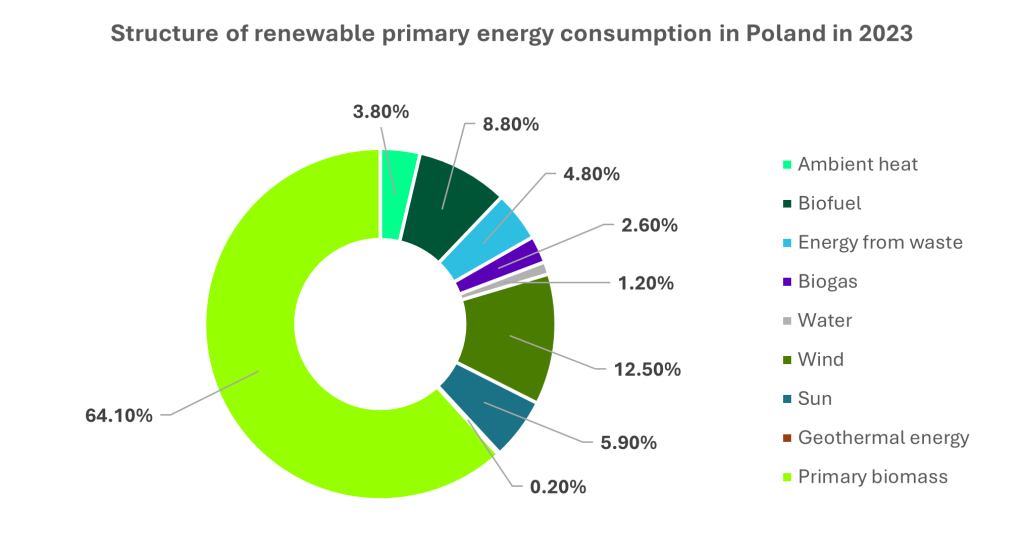Biomass: energy hidden in everyday waste
Biomass is a natural treasure hidden in our everyday surrounding – organic matter that comes from plants, animals and their waste that we can convert into energy. Imagine wood, plant leftovers or even waste from your kitchen being turned into heat, electricity or fuel for cars instead of being wasted. This is nature’s ecological response to our energy needs, reminding us that what we have given to the earth can come back to us in the form of clean energy.

Biomass is one of the oldest and most versatile renewable energy sources that not only connects us to the past but opens the door to a sustainable future.
Biomass past and present
For thousands of years, biomass, mainly in the form of wood, was the primary source of energy. People burned wood in bonfires, stoves and fireplaces to heat their homes or cook their meals. However, the use of biomass was limited to burning it in open hearths or simple cookers. This solution was only effective on a small scale and had many disadvantages. It emitted large amounts of pollutants such as soot, carbon dioxide (CO₂) and particulate matter. It was also inefficient as much of the heat escaped into the atmosphere and intensive wood logging was required, leading to deforestation in many regions.
The modern use of biomass is not just about burning wood but taking advantage of a wide range of technologies that allow for more efficient and environmentally friendly use of the energy contained in organic materials.
Biogas plants convert organic waste into clean and useful energy. You can think of them as huge stomachs in which bacteria do the hard work of converting food scraps, manure or agricultural waste into biogas. This process is friendly to the environment and promotes circular economy.
How does it work? Rotting rubbish, manure or food waste releases methane – a gas with a high energy value. In biogas plants, this waste is subjected to anaerobic bacteria that break down the organic matter, producing biogas. This is used to generate electricity and power vehicles in the form of compressed natural gas (CNG).
Waste incineration plants convert municipal waste into electricity, thus reducing the amount of waste going to landfill. There are currently eight incineration plants operating in Poland (in Białystok, Bydgoszcz, Konin, Kraków, Poznań, Szczecin, Rzeszów and Warsaw). These plants process municipal waste that cannot be recycled, converting it into electricity and heat through cogeneration systems – a technology that allows electricity to be generated and buildings to be heated simultaneously in a single process. Currently, the total capacity of incineration plants accounts for approximately 1% of the total volume of municipal waste generated in Poland.
Second-generation biofuels are another step towards greener transport and sustainable use of resources, especially in response to the limitations of first-generation biofuels. The latter, produced from edible feedstocks such as maize, sugar cane or vegetable oils, were controversial because they competed with food production and drove food prices up. Meanwhile, biofuels such as ethanol, made from agricultural waste, or biodiesel made from waste oil and animal fats, solve these problems by using raw materials that were previously considered useless.
Modern cookers and boilers: efficiency and environmental care
Today’s wood-burning technologies are an example of how traditional heating methods can be improved to meet modern needs. Modern cookers and boilers are high-efficiency appliances that minimise harmful emissions while ensuring user comfort.
One of the most popular examples is pellet boilers – small, compressed pellets formed from wood residues that burn evenly to provide stable heat. This makes them not only efficient, but also environmentally friendly, as they use waste from the timber industry.
Another solution is fireplaces with closed combustion chambers, which, thanks to their design, significantly reduce the number of pollutants entering the atmosphere, while providing a warm and a cosy atmosphere in the home.
The technologies listed are an example of how traditional energy sources can be transformed into modern, environmentally friendly solutions that combine convenience of use with care for the environment.
Biomass life cycle
Biomass is an excellent example of a raw material that fits into the idea of a closed-loop economy, where every stage of its life cycle is linked to nature. It all starts with plants, which absorb carbon dioxide from the atmosphere during growth through photosynthesis. The carbon, which becomes part of their structure, is then released back into the atmosphere when biomass is burned to generate energy. However, what distinguishes biomass from fossil fuels is that the process is carbon-neutral – the amount of carbon dioxide released during combustion is equal to that previously absorbed by the plants, so it does not contribute to the greenhouse effect.
An example can be found in the cycle of growing and processing agricultural residues. Agricultural residues, such as straw or stalks, which have no use in agriculture, have become a raw material for energy production. Once burnt, the biomass ash can be used as a natural fertiliser, closing the life cycle and returning to the soil to support the growth of new plants. This approach not only minimises waste, but also allows for sustainable use of resources, making biomass one of the greenest sources of energy.
Benefits of biomass
- The use of farming, forestry or household waste as an energy raw material helps to reduce the amount of waste going to landfill, in line with the idea of a circular economy.
- In addition, biomass supports the local economy, creating jobs in agriculture and processing industry, and
- enhances energy independence, reducing dependence on imported fossil fuels.
- Furthermore, when properly managed, biomass is associated with low greenhouse gas emissions.
Biomass is not only a source of energy, but also part of a sustainable lifestyle that promotes responsibility for the environment and natural resources. Its use helps reduce waste, supports the local economy and creates jobs while reducing dependence on fossil fuels. It is an energy that combines tradition with modernity and opens the door to a greener future.





